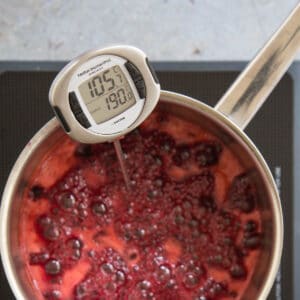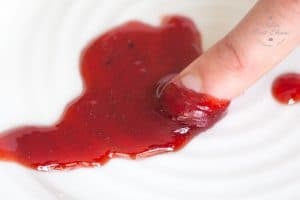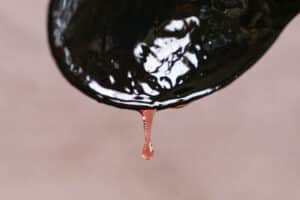
Find more recipes at fussfreeflavours.com

How to get a perfect jam set
Getting the perfect set when you make jam need not be daunting, and is really easy once you learn how. We'll tell you everything you need to know for perfectly set jam, jelly and other preserves every time.
Instructions
The Temperature Test
- Jam will generally set once it’s reached 105°C/220°F. The easiest way to watch the temperature is with a digital thermometer.

- Do make sure that you stir the jam well as you take the temperature, as it’ll be a lot hotter on the bottom of the pan than at the top near the edge.
- Temperature is only a guide - some jams need to be a little hotter to set. if the jam doesn't contain enough pectin, sugar or acid it might still not set.
The Wrinkle Test
- Place a couple of plates in the freezer before you start cooking the fruit, so that they’re ice cold by the time you want to test for setting point.

- When you want to test the set, take a teaspoon of boiling jam and tip it onto the cold plate. Allow to cool.
- Push your finger through the jam. It’s reached a setting point when it just wrinkles ahead of your finger. It’s a very small difference compared to unset jam, so this is a technique that rewards practice.
- If you boil the jam until you have large, obvious wrinkles that you will have a very hard set jam; so it is best to test little and often.
The Flake Test
- This is easy in that you need no special equipment or preparation beforehand. As the jam boils, pick up a spoonful with a large, long handled spoon. You want one with a narrow lip and that holds a good amount of jam – so a metal or plastic cooking spoon is perfect.

- Turn the spoon onto its side, so that the jam runs out back into the saucepan. When the jam is setting, you will notice a change in the way it runs off the spoon. The last few drops, in particular, will hang from the edge of the spoon.
Once setting point is reached
- Allow the jam to cool for a few minutes, and then pour into heated and sterilised jars and seal the lids. Allow to cool before labelling.
Notes
Jam, jelly, preserve setting is dependent on a combination of temperature, acidity, pectin and sugar.
Temperature is only a guide to being at setting point - a jam can reach the temperature at which it will set, but if it is lacking in pectin, sugar or acid it still will never set.
• Please note that the nutrition information provided below is approximate and meant as a guideline only.
• Unless stated otherwise cup conversions have been made with an online tool. For accuracy please check with your favoured conversion tool. We recommend buying inexpensive digital kitchen scales.